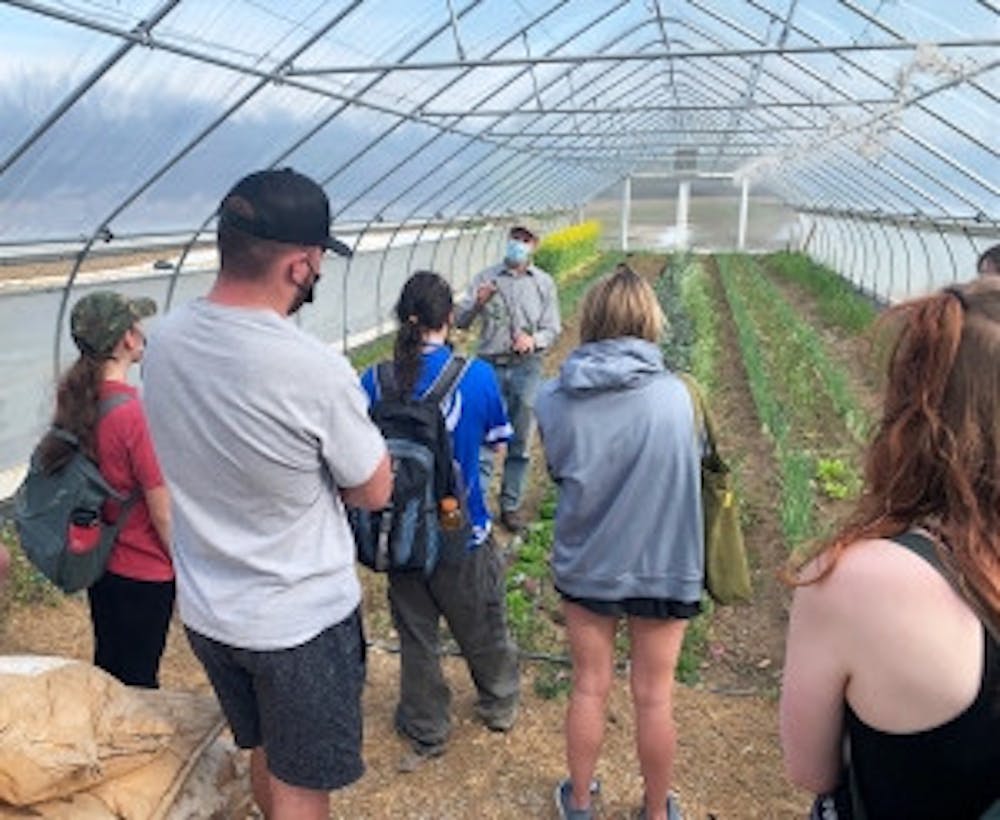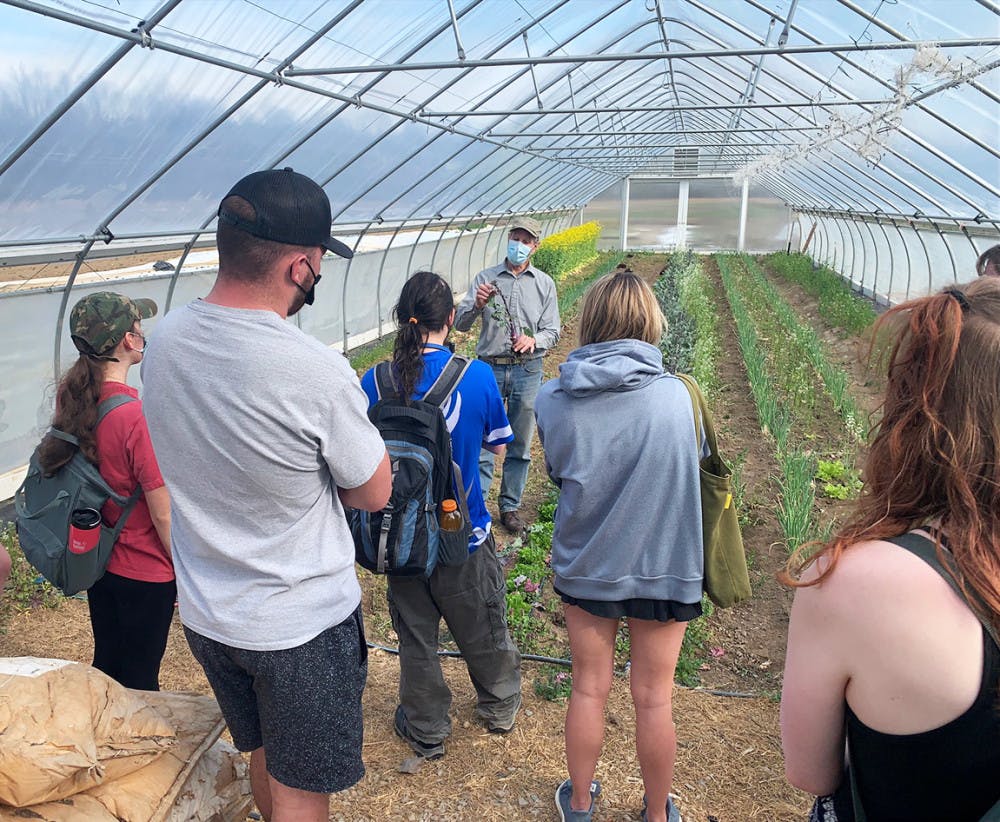Is the Miami farm viable without significant university support?
BY: FIONA LAWLER
The Miami University Institute for Food farm will be in a tough position this fall if it doesn’t grow revenue from its community supported agriculture program, sales to university dining and the community, grants and other funding. The institute’s mission is teaching students - often through experiential learning - about sustainable agriculture, healthy eating and nutrition. But the 5-year-old Somerville Road farm is heavily subsidized by the university and lacks dedicated faculty.
The 2021 farm budget projected a revenue shortfall of more than $111,000, a gap the university would have to fill. That would come as Miami continues to grapple with the budgetary repercussions of the Covid-19 pandemic. The bright spot: A team of Miami faculty, students and administrators is bringing new ideas to the table to bolster revenue and student involvement. Among those ideas are increasing CSA revenue, expanding programs to get students involved in the farm, and seeking new grants and other funding sources, according to Dr. Jonathan Levy, director of Miami’s Institute for the Environment and Sustainability (IES).
Levy oversees the Miami farm operation in the wake of the 2020 departure of its founder, Dr. Marguerite Shaffer. That’s heartening news to the hundreds of students who have taken class, volunteered or worked on special projects here.
"The farm is like a little escape from on-campus life and school,” explained Kyle Mason, who graduated from Miami in May with degrees in geography and sustainability. Mason volunteered at the farm through his IES/ETL 231 course in spring 2021. “It offers great hands-on experience in sustainable agriculture,” he said. “It's also really nice to know where your food is coming from.” That should matter to the Oxford community, Mason added.
Students from myriad majors contribute to Miami farm
The Institute for Food and its farm - part of IES - were not always in this precarious situation. The farm boasted a strong start in 2016, thanks to Shaffer, who was a professor of history and American studies. Shaffer’s background inspired her interest in healthy, sustainably grown food, and in bringing people together through the tastes of different cultures.
Shaffer used a combination of funding to launch the institute, according to a USDA grant application she wrote:
- $200,000 from the Miami Provost’s Office
- $150,000 from a USDA grant she landed; and
- $50,000 from the Gross Hutton Foundation.
She attracted students and faculty from many Miami departments to get involved in building, irrigating, powering, crop production and marketing the farm. Those departments include Electrical and Computer Engineering, Mechanical and Manufacturing Engineering, Individualized Studies, Environmental Science; Media, Journalism & Film; and Architecture. Shaffer piloted classes in food science and culture, produced projects about regional food culture, and hired a small staff to work the farm and teach students hands-on growing methods.

Enjoy what you're reading?
Signup for our newsletter
Among those key hires was Charles Griffin, an expert in sustainable farming who became director of farm productions and operations. Shaffer left Miami University for personal reasons in 2020 and the university has not filled the Institute for Food leadership position. But Griffin is working hard to stabilize the farm, alongside Levy and a group of other faculty and students.
“We do worry about the finances,” said Levy in an April interview. “Peggy Shaffer was the driving force of the financial aspect of the farm. She got USDA grants and money gifted from private donors and was able to set it all up.” Most of this funding was depleted in 2018. Dean Chris Makaroff of the College of Arts and Science has been covering some farm expenses from his budget since that time, said Levy, with gratitude.
A breath of fresh air
Step onto the Miami farm, and you will see why so many people want it to thrive. These 14 acres - 8 of them under crop - are a breath of fresh open air adjacent to Yager Stadium and the Miami athletic complex. The acreage is part of the historic Austin-Magie farm in Oxford; the farm house, in disrepair, still stands. Rows of vegetables, leafy greens, flowers and some fruits are planted almost year-round. Greenhouses, a solar array, a pump house, a produce wash house and converted container office dot the property, with a small parking lot accessible from Somerville Road. None of this was here in 2016.
It was just scruffy acreage, previously farmed conventionally, with a small vernal pool at the back that attracted ducks and geese in season. Shaffer saw a unique opportunity to expand liberal arts education into the earth. One of the hardest parts has been the finances.
The Miami University Institute for Food Statement of Impact published Nov. 11, 2020, listed its annual operating and production expenses at $154,460. That includes two staff positions: Griffin and Stephanie Beckner, the food operations and outreach assistant. Total sales revenue in 2020, the document said, was $56,770. Revenue was gleaned from more than 100 community supported agriculture (CSA) shares, sale of fresh greens to Miami Dining and produce sales at the City of Hamilton farmer’s market. In 2020, six CSA weekly food delivery options were offered, ranging from a 15-week Student Share, available in summer or fall, for $100, to a Double Share (serving two to four people) over 30 weeks for $620.
This year, two CSA packages were offered, according to the Institute for Food web pages. The price rose for a Single Share, of four to six food items weekly, to $200 for 15 weeks. The Double Share, with eight or more items per week, was $320 for 15 weeks, with discounts for those signing up for multi-season plans. CSA members pick up their Miami farm food on Thursdays at Cook Field on the Oxford campus. The options were designed to benefit the university and Oxford communities with locally produced, healthy food. But it’s clear, from the farm’s projected 2021 budget, that the farm needs creative revenue solutions. A grant from Miami alums Clark and Cathy Foy continues to help with the bottom line. Here’s the farm’s projected 2021 budget breakdown, provided by IES:
Planting an array of farm finance solutions
According to Griffin, the real value of the farm is what it gives Miami students. “Learning and experience for students is one of the biggest missions of the farm,” explained Griffin, who does much of the hands-on field teaching and mentoring. Levy agrees that educational courses and programs are key to the farm's survival. He is hoping to launch new programs to augment CSA and other sales.
“There are three possibilities, which will be implemented in combinations to keep the farm afloat,” Levy outlined:
- Increasing student enrollment in the new IES co-major Food Systems & Food Studies. This can be accomplished by attracting graduate students, internships and outside programming.
- Obtain more external grants and donations, with the help of Miami alumni and foundations.
- Generating more revenue from farm operations, including CSA member growth and commercial sales.
Explained Levy, “It's not enough to just sell produce - we need to be offering students experiential, hands-on learning.” The team of faculty and students working on solutions has considered summer programs for incoming first-years like in which students can work on the farm, learn about sustainable growing practices and explore related career fields.
Another method involves the Miami Bound Program in Sustainability, a currently two-day pre-semester immersion in the many sustainability aspects on campus, such as the geo-thermal plant, student EcoRep program, natural areas and, of course, the Miami farm. This specialty program was designed by Shaffer and Levy, and they won an Outstanding Interdisciplinary Perspective in Teaching Award from Miami’s Office of Liberal Education for it.
Levy wants to spark the interest of incoming students in the various IES co-majors, which could, in a domino effect, grow farm revenue. Hope abounds. But the clock is ticking, just as the Class of 2026 arrives on campus and fall crops mature in the Miami farm fields.
---------------
Fiona Lawler earned bachelor’s degrees in journalism and English literature from Miami University in May 2021. She wrote this article while a student in Prof. Annie-Laurie Blair’s spring 2021 environmental journalism class.




